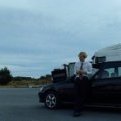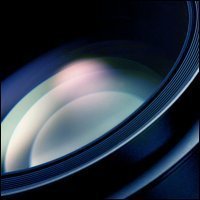
Christian Schonberger
Basic Member-
Posts
193 -
Joined
-
Last visited
About Christian Schonberger
- Birthday 03/29/1961
Profile Information
-
Occupation
Sound Department
-
Location
Lisbon
-
My Gear
owned Beaulieu 6008S, own K-3 Super 16mm, fully converted.
-
Specialties
Professional musician, composer, arranger, MIDI, sound engineer, original music for film and tv commercials. Interests: film making, Super 16mm.
Recent Profile Visitors
6,110 profile views
-
Hi all, Well I hope this hasn't been asked before. If so, I apologize. Does anyone know what hand held camera Stanley Kubrick used for the handheld shots (moon monolith) in 2001? The two 65/70mm cameras I can see in Photos are an unblimped Mitchell 65 and a blimped Panavision (very likely based on the Mitchell, IMDB says: Mitchell BFC 65mm). The handheld scenes fit perfectly into the 65/70mm footage, so I find it hard to believe that it's a 35mm (Arri 35 II C?) since it would need a closely matching blow up for the original neg assembly. Any input appreciated.
-
Hello, Christian here. Thinking about getting a Scoopic. So I would like to ask if you think it is possible to do an Ultra 16 conversion at home by yours truly having patience, reasonable skills and tools. Any kind of information highly appreciated. Thanks in advance.
-
K3 and shutter at end winding
Christian Schonberger replied to Luigi Castellitto's topic in Russian Gear
Well I own a K-3 which runs fine after the obligatory steps (gate polishing, loop formers removed, light leaks taped, etc.). When the spring runs out, the shutter stops at a random position on my K-3, but it takes just a small touch counterclockwise with the wind up blade (if that's the right word) and the shutter mechanism safely snaps into place. This also ensures that the pulldown claw is engaged and the film is held firmly in place. Hope this helps. -
Hmm, there are a lot of 1990s and 2000s movies shot and Kodak (source: IMDB - I might add that I provided a lot of information which was approved) and I am not sure that being cheaper has to do with it. Also: how does a particular print film stock affect the final result from a print neg on a contact printer? I think we need to know the entire process (printers and every film stock used at each step). Sorry if I sound nitpicking, but each step is important.
-
Excellent point! I see a lot of emulation of the '60s and '70s look with its often muddy browns, some even on smaller film formats (35mm 2-perf Techniscope for "American Hustle" comes to mind) but somehow the '80s look (I am simplifying here obviously) seems to be hard to nail. "It Follows" tried that on digital and it was more the set design and subject matter that evoked the 1980s than he actual image. And of course it has to do with the genre "Hell Or High Water" (loved it!) is what you could call a neo-western. I was put off by its digital look constantly - despite otherwise great cinematography, story and acting. I think it would have looked miles better if shot on Super 35mm (or even Super 16, as Wes Anderson proved with Moonrise Kindom, all Vision 3 200T, Super 16). BUT it might have been just the color grading and digital post. I usually still can spot very fast (often after just a few shots or less) if it's film or digital. I cannot overemphasize it enough: I'm not a film purist. My preference for film (there is a certain quality that still seems very hard to emulate, especially when a movie tries that), especially on an emotional level, is my own personal opinion and I fully respect others.
-
David, Thanks for the information. I am positive that some remaining (please keep in mind that I am not an expert) characteristics of film can be emulated to near perfection in the D.I. IF one wishes. I am talking about things like highlight roll off in certain situations (it obviously all becomes more evident on smaller film formats) or different grain patterns on different hues. It's just a matter of creating the correct algorithms. I remember a few years ago when digital simulations of tube distortion and speaker saturation (all very desirable effects in certain genres of music) were completely unconvincing. Now these can be re-created by software extremely convincingly. So my conclusion is that any organic behavior of film which can't be recreated convincingly yet (if desired, that is) it will be just a matter of time. Well I still personally prefer the look and feel of film for certain moods and feels, but I don't believe in "magic". It's definitely just a matter of truly understanding how it works and it can be modeled (simulated) with software. Again: if desired. Thanks for your input, Christian
-
Mark and Philip: Thank you for the information! Well I was aware of the soft filters (stockings) and (at least with Vision 3) the 200T with an 85 filter is quite popular. I know that the Vision 2 looks somehow slightly colder than the later Vision 3. Pull processing would also be one of my guesses, but the article in American Cinematographer actually explains it in accurate detail. Anyway: love the look and feel of the movie. Very unique and perfect to create the intended mood an feel. Thanks again, Christian
-
Hello Group, Just watched "Atonement" (2007) and it immediately looked like Fuji to me. It had those typical saturated and "airy" colors - as opposed to the more "earthy" colors usually found on (Eastman) Kodak stocks from EXR through Vision3. I know that's a broad generalization, but words can say only so much. IMDB states that it was shot on Kodak Vision 2, but somehow it doesn't look like it at all. Perhaps the digital color grading changed it dramatically without looking "tweaked". With recent digital color grading it is hard to tell anyway which film stock was used, especially when the grading is heavy. Still, my bet would have been Fuji (I know there were different neg stocks, not only regarding speed (ASA/ISO), but to my eyes this almost screams Fuji, both in the daylight and in the night time footage. Any information about how this (great) look was achieved and which stock was used is highly appreciated. Thanks in advance, Christian
-
Phil, My basic idea is that Super 16mm, even with modern Kodak Vision 3 neg stock, is not
- 25 replies
-
Robin, No need to apologize. I mean it. Got all the information I need from the thread. Thanks for that. Will look around for a really nice, reliable S 16 camera and good glass. Knowing how to work with it and digital post done just right will deliver all I'll ever need. Merry Christmas to all! Christian
- 25 replies
-
Robin, Thanks for the reply. No problem with the grain on S16. It's fine enough (obviously depending on stock) for my projects and I tend to be really careful to nail the exposure (including lower ASA/ISO ratings on color neg if needed). About threading: at the moment I am shooting with a humble S 16 modded K-3 (loop formers removed, quirks solved) and I have no problem with the really fiddly threading, including double checking and open running a few bursts, before closing and tape sealing, to make sure the loops are good, stay and all runs fine). Sure: with a coax mag it's different. No film chamber and the pressure plate is part of the mag itself. I'm fine with both - I'm not a professional, so I take my time (and keep the gate clean hahaha) as long as the body/mag work perfectly. IMHO 16mm/S 16 needs really good glass, because you don't need to "bang up" an image that's too clean unless you want the Roger Deakins (deakinizer) effect. Happy holidays, Christian
- 25 replies
-
Tyler and Stuart: thanks a lot for your kind replies! Yup: after thinking it through: Super 16mm is the way to go - it is easier to get a good body and good glass - and modern scans of the camera original neg look really good. Yes: that was my idea: since I also crop the sides (on 2-perf 35mm that is), I guesstimated that a standard lens would be 30-something millimeters. of course I would go Super 35mm 3-perf in the blink of an eye. But that will be forever out of reach. Thanks again for sharing your thoughs and expertise! Merry Christmas (or whatever it is you are celebrating)! Happy shooting (with a camera of course)! Christian
- 25 replies
-
Samuel and Tyler, Thanks a lot for your fast replies. Don't have the $$$ right now, otherwise I'd buy that sweet Arrifex right now. That model even exceeds what I was hoping for. AWESOME! Gotta wait until I have enough money. Thanks for the info regarding the focal lengths. Since I am very likely not shooting in the "scope" format (1:2.35-ish), but rather (as I mentioned) in 1:1.85 or the slightly less wide 16:9, for various reasons - the crop factor comes in. I know it's all a matter of the way one looks at it. A 50mm lens is always a 50mm lens. On 2-perf 1:1.85 I just have the sides cropped off a little (will compose protected for it though), hence my estimated 30 simethingmillimeter as a standard. But one can see it as a cropped 50mm. No problem: got all that figured out. BUT that's all a pipe dream as for now. Just wanted to check. LOVE the good old Arriflex 35 IIC. Kubrick loved this machine (as you all know of course) The new restored versions (I suppose from the camera originals, so no dye transfer and/or optical anamorhic printing onto 4.perf 35mm) of The Leone "Dollar" trilogy and Once Upon A Time In The West look just outstanding. "Shame" (2001, Arricam Lite, Techniscope) also was filmed on 2-perf. Looks great! Have a great Holiday season and thank you! Christain Thanks again
- 25 replies





